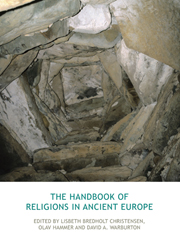Book contents
- Frontmatter
- Contents
- A note on Greek and Latin sources
- Abbreviations and short titles
- 1 Introduction
- PART I PREHISTORIC RELIGIONS
- PART II ANCIENT EUROPE IN THE HISTORICAL PERIOD
- 12 Minoan and Mycenaean religion
- 13 Etruscan religion
- 14 The religions of the Iberian Peninsula
- 15 Italic religion
- 16 Roman religion
- 17 Ancient Greek religion
- 18 The Graeco-Roman cult of Isis
- 19 The cult of Mithras
- 20 Religious Platonism: philosophy and religion in the Platonic tradition
- 21 Insular Celtic religion
- 22 Continental Germanic religion
- 23 Pre-Christian Anglo-Saxon religion
- 24 Old Norse religion
- 25 Slavic religion
- 26 Baltic religion
- 27 Religion in prehistoric Finland
- 28 Sami religion
- Timeline of key dates
- Contributors
- References
- Index
13 - Etruscan religion
from PART II - ANCIENT EUROPE IN THE HISTORICAL PERIOD
- Frontmatter
- Contents
- A note on Greek and Latin sources
- Abbreviations and short titles
- 1 Introduction
- PART I PREHISTORIC RELIGIONS
- PART II ANCIENT EUROPE IN THE HISTORICAL PERIOD
- 12 Minoan and Mycenaean religion
- 13 Etruscan religion
- 14 The religions of the Iberian Peninsula
- 15 Italic religion
- 16 Roman religion
- 17 Ancient Greek religion
- 18 The Graeco-Roman cult of Isis
- 19 The cult of Mithras
- 20 Religious Platonism: philosophy and religion in the Platonic tradition
- 21 Insular Celtic religion
- 22 Continental Germanic religion
- 23 Pre-Christian Anglo-Saxon religion
- 24 Old Norse religion
- 25 Slavic religion
- 26 Baltic religion
- 27 Religion in prehistoric Finland
- 28 Sami religion
- Timeline of key dates
- Contributors
- References
- Index
Summary
ETRUSCAN CULTURE
It is only since the eighth century BCE that we can legitimately speak of the “Etruscans”, as it is from this time that they began to write their distinctive, non-Indo-European language. They wrote using the alphabet they borrowed and adapted from the Greeks colonizing Italy at that time – but there is no doubt that this unique culture and ethnic group had already been in Italy for some time, probably since the Neolithic. By the dawn of the Italian Iron Age, shortly before 1000 BCE, all the elements of early Etruscan culture can be detected in the region of Etruria (Tyrrhenian Tuscany), in pockets in the Po Valley/Upper Adriatic, and in Campania (Bay of Naples). This protohistoric material culture is arbitrarily called the Villanovan culture, named after an archaeological site outside Bologna (Etruscan Felsina).
Extensive contacts with settlers and traders from the Levant (Phoenicia, Syria) and Greece (especially Euboea, Corinth and, later, Athens) seeking metals and other resources resulted in rich hybrid traditions of urbanism, literacy, figurative art, and some of the trappings of formalized religion as practised in the eastern Mediterranean and Near East. Early commercial contact of Etruscan arms/metal dealers with northern Europe is attested as well, by finds of inscribed armour, illustrating the means by which the Etruscan alphabet reached the far north and became the model for the runic futhark; apparently cross-fertilization between the cultures was more extensive than generally recognized (see G. Bonfante 1981).
- Type
- Chapter
- Information
- The Handbook of Religions in Ancient Europe , pp. 139 - 155Publisher: Acumen PublishingPrint publication year: 2013



